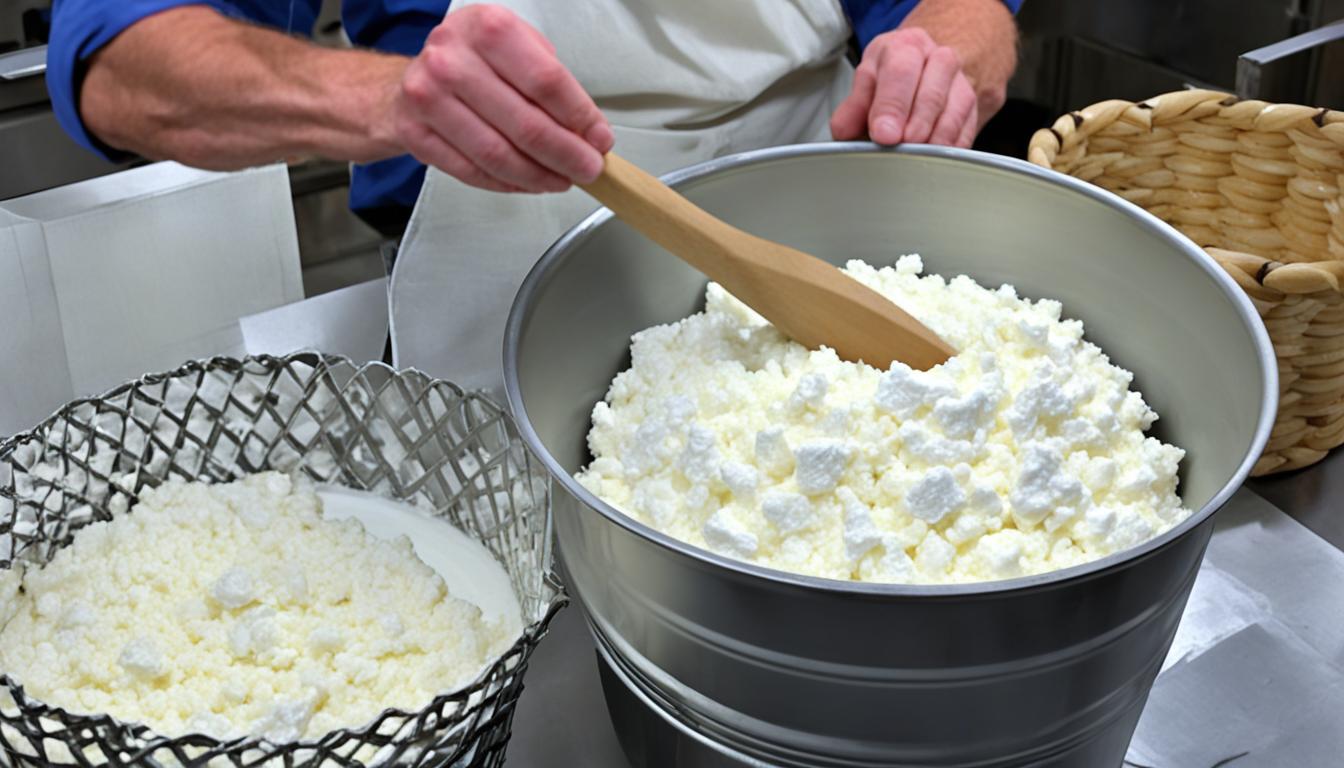Have you ever wondered how cottage cheese is made? It’s a delicious and versatile cheese that can be enjoyed in various ways. But what goes into the production process of this creamy delight? Join us as we take a closer look at the cottage cheese manufacturing steps and uncover the secrets behind its creation.
Key Takeaways:
- Discover the step-by-step process of making cottage cheese
- Learn about the history and origin of this popular cheese
- Explore the uses and substitutes of cottage cheese in cooking and baking
- Find out how to store and freeze cottage cheese for maximum freshness
- Uncover the benefits and versatility of homemade cottage cheese
The History of Cottage Cheese
Cottage cheese, a beloved dairy product, has a fascinating history that dates back to ancient times. Its origins can be traced back to Mesopotamia around 3,000 BC, where it was a staple in the diet of early farmers and herders.
However, it was not until the mid-19th century that cottage cheese gained popularity in America. As the name suggests, it was traditionally made in farmhouses or cottages using excess milk from butter making. This made it an accessible and economical food option for many households.
During World War I, cottage cheese gained further prominence as an alternative to meat products due to rationing measures. Its versatility and nutritional value made it a valuable source of protein during this challenging time.
The true heyday of cottage cheese came in the 1970s when it became a staple in dieting circles. With its low-fat content and high protein levels, cottage cheese became synonymous with health-conscious eating. However, its popularity declined in the 2000s with the rise of yogurt as a preferred dairy option.
Nevertheless, in recent years, cottage cheese has experienced a resurgence in popularity. Health-conscious consumers are rediscovering the nutritious benefits of this versatile cheese. Its high protein content and low sugar levels make it an excellent choice for those seeking a healthy snack or ingredient.
As we delve further into the manufacturing process and the various uses of cottage cheese, its enduring popularity and place in our culinary landscape become evident.
The Cottage Cheese Manufacturing Process
In the world of dairy products, cottage cheese holds a special place as a versatile and delicious option. The manufacturing process of cottage cheese involves several key steps that result in its unique texture and taste.
Step 1: Curdling the Milk
The journey of cottage cheese starts with curdling the milk. Enzymes or lactic acid bacteria are added to the milk, which triggers the curdling process. This curdling forms curds and whey, separating the milk solids from the liquid.
Step 2: Cutting the Curds
To achieve the desired consistency and size of the curds in the final product, they are cut into smaller pieces. This is done using a specialized tool called a curd cutter. By controlling the size and shape of the curds, the manufacturers can create cottage cheese with the perfect texture.
Step 3: Draining and Mixing
After cutting the curds, the whey is drained out, leaving behind the curds. The curds are then mixed with cream to enhance the taste and texture of the cottage cheese. This addition of cream adds richness and creaminess to the final product.
Step 4: Rinsing and Pressing
Once the curds are mixed with cream, they are rinsed to remove any excess whey and other impurities. This rinsing ensures that the cottage cheese is clean and free from any unwanted flavors. The curds are then pressed to remove additional moisture, which helps in achieving the desired consistency.
Step 5: Packaging and Shipping
After the curds have been rinsed and pressed, the final product is ready to be packaged and shipped for consumption. The cottage cheese is generally packaged in containers that preserve its freshness and extend its shelf life.
The manufacturing process of cottage cheese involves curdling milk, cutting the curds, draining the whey, mixing with cream, rinsing, pressing, and packaging for shipment. Each step is crucial in creating the creamy and nutritious cottage cheese that we enjoy today.
Homemade Cottage Cheese Recipe
Making cottage cheese at home is a simple process that requires only three ingredients: milk, vinegar, and salt. With these basic ingredients, you can create a delicious and healthy cottage cheese right in your own kitchen. Here’s a step-by-step guide to making homemade cottage cheese:
- Heat the milk: In a large pot, heat the milk over medium heat until it reaches a temperature of 120°F (49°C). Stir occasionally to prevent scorching.
- Add vinegar: Once the milk reaches the desired temperature, add vinegar to the pot. Use approximately 1/4 cup of vinegar for every 1 gallon of milk. Stir gently to mix the vinegar evenly.
- Curdle the milk: Allow the milk to sit undisturbed for about 10-15 minutes. During this time, the milk will curdle and form curds.
- Strain the curds: Place a colander lined with cheesecloth over a large bowl. Pour the curdled milk into the colander, allowing the whey to drain off. The curds will remain in the cheesecloth.
- Rinse the curds: Rinse the curds under cold water to remove any residual vinegar and acidity.
- Mix in salt: Place the rinsed curds in a bowl and mix in salt to taste. The salt will enhance the flavor of the cottage cheese.
And that’s it! Your homemade cottage cheese is ready to be enjoyed. You can enjoy it plain, with your favorite fruits or vegetables, blend it into smoothies, or use it in a variety of recipes.
Here’s an example of how you can enjoy your homemade cottage cheese:
| Recipe | Ingredients | Instructions |
|---|---|---|
| Cottage Cheese and Fruit Parfait |
|
|
Whether you enjoy it on its own or in a delicious recipe, homemade cottage cheese is a versatile and nutritious option for your meals and snacks.
Cottage Cheese Uses and Substitutes
Cottage cheese is a versatile ingredient that can be used in a variety of ways. Here are some creative and delicious uses for cottage cheese:
- Eating it plain: Enjoy cottage cheese as a simple and nutritious snack on its own.
- Pairing with fruit or vegetables: Top cottage cheese with fresh berries, sliced peaches, or chopped vegetables for a healthy and satisfying meal.
- Blending into smoothies: Add cottage cheese to your favorite smoothie recipes to boost the protein content and create a creamy texture.
- Using as a mayonnaise replacement: Substitute cottage cheese for mayonnaise in recipes like tuna salad or egg salad for a lighter and protein-packed alternative.
When it comes to cooking, cottage cheese can also be used as a substitute for other dairy products. Here are some common cottage cheese substitutes:
| Substitute | Texture | Best Use |
|---|---|---|
| Ricotta cheese | Smooth and creamy | Baking, lasagna, stuffed pasta dishes |
| Mascarpone | Rich and velvety | Desserts, especially in Tiramisu |
| Feta cheese | Tangy and crumbly | Salads, dips, and spreads |
| Sour cream | Smooth and tangy | Toppings for baked potatoes, Mexican dishes |
| Cream cheese | Rich and creamy | Bagels, cheesecakes, frostings |
| Yogurt | Smooth and tangy | Smoothies, dressings, marinades |
| Kefir | Drinkable and tangy | Smoothies, baked goods, dressings |
| Mozzarella cheese | Melted and stretchy | Pizza, lasagna, casseroles |
| Goat cheese | Creamy and tangy | Salads, pasta dishes, cheese boards |
Experimenting with these substitutes can add a new twist to your recipes while still maintaining the desired texture and flavor.

Why Cottage Cheese Substitutes?
Cottage cheese substitutes can be used for various reasons. Some people might have dietary restrictions or preferences that require them to avoid cottage cheese. Others may simply want to switch things up and try new flavors and textures in their dishes. Regardless of the reason, knowing the alternatives allows for greater culinary flexibility and the ability to cater to different tastes and dietary needs.
Storage and Freezing of Cottage Cheese
When it comes to storing cottage cheese, it’s important to follow a few guidelines to maintain its freshness. By properly storing cottage cheese, you can make sure it stays delicious and safe to consume for as long as possible.
For optimum storage, place your cottage cheese in an airtight container. This prevents air from entering, which can cause spoilage. Additionally, it’s recommended to store the container upside down in the refrigerator. This helps create a seal and slows the growth of bacteria, further extending its shelf life.
Once opened, cottage cheese typically stays fresh for about 10 days in the refrigerator. However, it’s always a good idea to check for any signs of spoilage, such as an off smell or mold, before consuming.
Now, let’s talk about freezing cottage cheese. While you can freeze cottage cheese, it’s important to note that freezing may slightly alter its texture. If you plan to eat the cottage cheese as is or use it in recipes that require a creamy texture, it’s best to enjoy it fresh.
However, if you’re planning to use cottage cheese in cooked recipes like lasagna, where the texture difference may not be noticeable, freezing can be an option. Simply transfer the cottage cheese to a freezer-safe container and label it with the date. When you’re ready to use it, thaw it slowly in the refrigerator and give it a gentle stir before incorporating it into your dish.
Remember, the quality of cottage cheese may change after freezing, so it’s best to assess its texture and taste before consuming.
Storing and freezing cottage cheese can help you prolong its shelf life and enjoy it at your convenience. Just remember to keep it in an airtight container, store it upside down in the refrigerator, and use it within the recommended time frame. And if you decide to freeze cottage cheese, be aware of the possible texture changes. Now that you know how to store and freeze cottage cheese, you can always have this versatile ingredient on hand for your favorite recipes!
Conclusion
In conclusion, cottage cheese is a versatile and delicious ingredient that is made from curdled milk and cream. The production process involves curdling the milk, cutting the curds, draining the whey, and mixing the curds with cream. This results in a creamy and flavorful cheese that has been enjoyed for centuries.
Throughout its rich history, cottage cheese has experienced fluctuations in popularity, but it has remained a staple in many households. Whether store-bought or homemade, cottage cheese can be enjoyed in various ways. It can be eaten plain, paired with fruits or vegetables, blended into smoothies, or used in cooking and baking. Its mild taste and creamy texture make it a versatile ingredient that enhances the flavors of any dish.
Proper storage and handling are crucial to ensure the best quality and taste of cottage cheese. When stored in an airtight container in the refrigerator, cottage cheese can last for about 10 days after opening. Freezing cottage cheese is also an option, although it may slightly alter its texture.
In summary, cottage cheese is a nutritious and delicious food that can be enjoyed in many ways. Its versatility, rich history, and potential health benefits make it a popular choice for people of all ages. Whether eaten as a snack, added to a recipe, or used as a substitute, cottage cheese is a wonderful addition to any kitchen.
